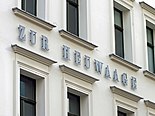To the hay scales
Zur Heuwaage is the name of a residential and commercial building in the north-eastern city of Leipzig . The name goes back to the urban large scale, the so-called hay weigher, which was here for over 300 years.
Location and shape
The building with the address Ritterstraße 50 is the southeast corner house where the Ritterstraße joins the Brühl . The six-storey house is to be assigned to the architectural style of classicism . It has seven window axes to Ritterstrasse and four to Brühl. The corner is bevelled and has door-high window openings on the upper four floors. Above the windows of the 1st to 3rd floor find Verdachungen . The hipped roof , assigned to the window axes, supports the dormer roof . Shops are located on the ground floor.
history
1535 took over the guilds of butchers, blacksmiths, tanners and shoemakers of the city, the property of the family of Wiedebach. They set up their granary (warehouse) here . In 1558 the city council had the city hay scales installed in the building, with which large loads, including wagons if necessary, could be determined. The predecessor was mentioned as a flat scales for the Brühl in 1511. In 1619 the scale received a new building in half-timbered construction, which remained until 1856 and which was often depicted with its counterpart, the Georgenhaus , built in 1701 . New scales were built into the half-timbered building in 1716 (see below).
After the weighing building was demolished, the residential and commercial building that still exists today was built in 1856. It was only slightly damaged in World War II and extensively renovated after 1990.
The Leupold balance
In 1716, the city council gave the Leipzig-based mechanic Jacob Leupold the order to build a new scale for heavy loads in the weighing building at the end of Ritterstraße. He built a device based on the principle of high-speed scales , which means that due to the different lengths of the sides of the balance beam, the total mass of the goods to be weighed does not have to be placed as a counterweight using the laws of levers. The balance is established with a tare weight that can be moved on the balance beam and the result of the weighing is read off on a scale. By varying the suspensions and additional counterweights, four weighing ranges between 2 and 50 centners can be set and an accuracy of one Leipzig pound can be achieved. Leupold wrote 14-page instructions for use.
literature
- Horst Riedel, Thomas Nabert (ed.): Stadtlexikon Leipzig from A to Z . 1st edition. Pro Leipzig, Leipzig 2005, ISBN 3-936508-03-8 , pp. 315 .
- Peter Schwarz: Millennial Leipzig. From the beginning to the end of the 18th century . 1st edition. tape 1 . Pro Leipzig, Leipzig 2014, ISBN 978-3-945027-04-2 , pp. 175 .
Web links
- House at the Heuwaage Leipzig. In: architektur-blicklicht.de. Retrieved March 3, 2019 .
Individual evidence
- ^ Peter Schwarz: The millennial Leipzig. From the beginning to the end of the 18th century . 1st edition. tape 1 . Pro Leipzig, Leipzig 2014, ISBN 978-3-945027-04-2 , pp. 175 .
- ↑ The Ritterstrasse 50, "Zur Heuwaage". In: The Ritterstrasse. Retrieved March 3, 2019 .
- ^ Peter Schwarz: The millennial Leipzig . From the beginning of the 20th century to the present. 1st edition. tape 3 . Pro Leipzig, Leipzig 2015, ISBN 978-3-945027-13-4 , pp. Card 192/193 .
- ↑ Leupold as a technician. In: German Museum. Retrieved March 3, 2019 .
- ↑ In Saxony 1 quintals = 51.4 kg
- ↑ 1 Leipzig pound = 467.625 g
- ^ Jacob Leupold: The Leipziger Heuwaage ... (digitized version of the original description). Retrieved March 3, 2019 .
Coordinates: 51 ° 20 ′ 31.5 ″ N , 12 ° 22 ′ 47.4 ″ E





